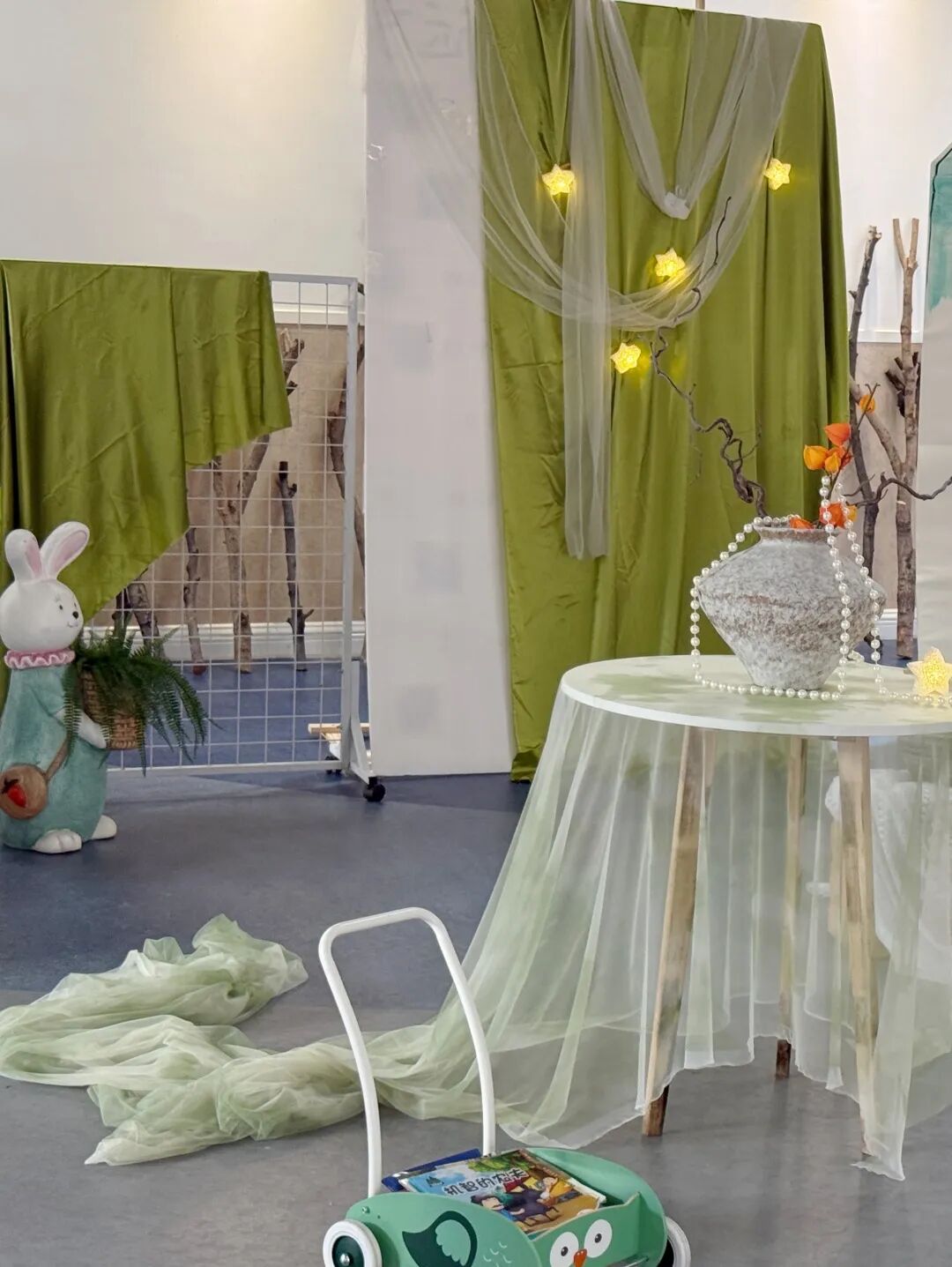孩子有一百种语言,每一种都应该被倾听与探索;
Children have a hundred languages each of which should be listened to and explored;
孩子有一百种游戏,每一种都应该被尊重与看到;
A child has a hundred games, each of which should be respected and seen;
孩子有一百个想法,每一个都应该被理解与鼓励。
Children have a hundred ideas, each of which should be understood and encouraged.
每个孩子都是天生的思考者,有着自己独特的思想,时刻都在用自己的方式探索与表达着对这个世界的认识。虽然由于年龄特点限制了他们很多口头或书面表达的方式,但也激励了他们创造出更多的属于自己的表达方式。
Every child is a born thinker with his own unique thoughts and is always exploring and expressing his understanding of the world in his own way. Although age limits many of their oral and written expressions, it also encourages them to create more of their own.
作为教师,我们应该成为孩子表达的倾听者与翻译家,不仅要支持孩子的小脑袋里千奇百怪的想法,像朋友一样去与孩子交流沟通,参与他们的头脑风暴,共同探索碰撞思维的火花;还要善于挖掘不同幼儿的表征方式,因材施教,将幼儿生活中熟悉的、感兴趣的事作为课程资源,赋予生活教育价值,使教育更贴近生活。
As teachers, we should become the listeners and translators of children’s expressions, not only to support the strange ideas in children’s small brains, but also to communicate with children like friends, participate in their brainstorming, and jointly explore the spark of collision thinking; It is also necessary to be good at exploring the representation of different children, teaching students according to their abilities, taking the familiar and interested things in children’s life as curriculum resources, giving life education value, and making education closer to life.
一
什么是幼儿表征?
What is infant representation?
“表征”是幼儿思维内化的过程,是指幼儿使用大量的图像和符号来表达自己的想法。图形表征是一种记录和记忆,是幼儿一种更具认知性的参与,是幼儿通过自己特殊的图形、符号对自己思维的记录表达。幼儿表征的方式包括:语言、涂画、肢体、眼神等。
“Representation” is the process of internalization of children’s thinking, which means that children use a large number of images and symbols to express their ideas. Graphic representation is a kind of recording and memory, a more cognitive participation of children, and a recording expression of children’s thinking through their own special graphics and symbols. Children’s representation includes: language, painting, body, eyes and so on.
The representation of children of different ages
|
|
|
|
|
|
小班幼儿的表征
Small class children’s representation
小班幼儿使用表征时的特点是记录自然事物外在的、整体性特征。通过使用简单的线条勾画,表达自己对周围事物、现象的认知及情绪情感。因此,小班的老师在引导幼儿用简单语言分享表达的同时,坚持鼓励幼儿做简单的表征。
The characteristics of small class children’s use of representation is to record the external and holistic characteristics of natural things. Through the use of simple lines to draw, express their cognition of the surrounding things, phenomena and emotions. Therefore, while guiding children to share expressions in simple language, teachers in small classes insist on encouraging children to do simple representations.
中班幼儿的表征
Representation of middle-class children
相比于小班幼儿,中班幼儿在做表征的过程中,关注事物内在的、细节性的特征,通过表征表达主观的内容或感受。
Compared with small class children, middle class children pay attention to the internal and detailed characteristics of things in the process of representation and express subjective content or feelings through representation.
大班幼儿的表征
The representation of children in large classes
大班幼儿表征从形象思维不断向抽象思维转化,想象力也在不断发展。孩子们将一天中最开心、记忆最深刻的事情用绘画的形式记录下来,大胆的去表达自己内心的想法,孩子们的想象力和表现力在画纸上体现的淋漓尽致。
the representation of children in large classes is constantly transformed from image thinking to abstract thinking and the imagination is constantly developing. Children record the happiest and most memorable things of the day in the form of painting and boldly express their inner thoughts. Children’s imagination and expression are vividly reflected on the drawing paper.
《幼儿园保育教育质量评估指南》中指出
“Kindergarten Education Quality Assessment Guide” points out
“重视幼儿通过绘画、讲述等方式对自己经历过的游戏、阅读图画书、观察等活动进行表达表征,教师能一对一倾听并真实记录幼儿的想法和体验。”基于此,我们学会放手,重视幼儿的表达特征,在“一对一倾听”中看见幼儿的成长。
“Attach importance of drawing, telling and other ways the children can express their own experience during games, reading picture books, observation and other activities, teachers can listen to one to one and truly record children’s ideas and experiences.” Based on this, we learn to let go and pay attention to the expression characteristics of children and see the growth of children in “one-on-one listening”.
三
教师“一对一倾听”的方法与策略
The methods and strategies of “one-on-one listening” by teachers
1.“不会画”中体验“一对一倾听”
Experience “one-to-one listening” in “No Painting”
对于小班幼儿的“一对一倾听”,常见的问题是“不会画”。这是他们初次踏入新环境的一个挑战。为了解决这个问题,我们可以采取一些针对性的策略:
For the “one-on-one listening” of the small class children, the common problem is “cannot draw”. This is a challenge for them to step into a new environment for the first time. In order to solve this problem, we can adopt some targeted strategies:
(1)技能技巧渗透式倾听
Skill Infiltration Listening
对于绘画能力弱、拿笔困难的幼儿,进行一对一指导,示范握笔姿势和绘画技巧。同时,在日常活动当中,引导幼儿做画点、连线的游戏,提高幼儿绘画技巧。例如:个别孩子的绘画能力相对较弱,乐于谈论自己感兴趣的话题。在教师指导过后,孩子的表征记录有了明显的变化,从一开始只能用单根彩色线条来表示物体的基本形态,到后来能够画出游戏内容和场景的基本特征。虽然语言比较稚嫩,但已经能够表达出简单的短句。
For children with weak drawing ability and difficulty in holding a pen, one-on-one instruction is provided to demonstrate pen holding posture and painting skills. At the same time during daily activities, guide children to draw points and connect games to improve children’s painting skills. For example, individual children’s painting ability is relatively weak and they are happy to talk about topics they are interested in. After the teacher’s guidance, the child’s representation record has significantly changed, from the beginning can only use a single-color line to represent the basic form of the object and later can draw the basic characteristics of the game content and scene. Although the language is relatively immature but already can express simple short sentences.
(2)多样方式体验式倾听
Experiential listening in various ways
越来越多的幼儿尝试用绘画记录自己的游戏,出现了多种有趣的表征方式。例如:孩子用积木拓印来记录自己的房子,但后来不再依赖这种方法,而是直接在建筑区搭建积木时进行描述,并且还会滔滔不绝讲述着和谁一起玩、搭建了什么、是什么形状等内容。
More and more children try to record their games by drawing and a variety of interesting representation methods will emerge for example, a child records his or her house with building blocks but then the child no longer relies on this method but directly describes the building blocks in the construction area and will talk about who to play with, what to build, what shape, and so on.
|
|
|
|
|
|
2、案例追踪中感悟“一对一倾听”
Perception of “one-on-one listening” in case tracking
案例背景:12月初,中班的植物角在老师和小朋友的布置下变成了冬日里最亮丽的一处角落。班级的浩浩小朋友带来了一只小乌龟,并安置在了植物角,吸引起了大家的注意。第二天早上这只乌龟不见了,孩子们针对这个问题展开了讨论。
Case background: In early December, the plant corner of the middle class became the most beautiful corner in winter under the arrangement of teachers and children. The Haohao children of the class brought a small turtle and placed it in the corner of the plant attracting everyone’s attention. When the turtle disappeared the next morning, the children discussed the problem.
倾听猜想记录一:
Listen to guess record 1
会不会爬到楼下了?不会的,楼梯那么高,它会滚下去的。会不会爬到柜子里了?会不会去其他班级了?大家带着疑问,多处寻找无果,决定把乌龟有可能逃跑的地方画下来,同时,教师将他们的猜测根据表述记录下来。
Will he go downstairs? No, the stairs are so high, I will roll down. Could he have crawled into the locker? Did he go to another class? With questions and many fruitless searches, the students decided to draw down the places where the tortoise might escape. Meanwhile, the teacher recorded their guesses according to the expressions.
猜想记录二:
Guess record 2
第二天,幼儿在老师的协助下,终于找到了那只乌龟,并放回原处,为了防止乌龟逃跑,幼儿商议用盖子盖起来,盖子上再加一块石头。如果乌龟再次逃跑怎么办?为此,幼儿又一次将乌龟可能逃跑的路线图画了下来,教师通过谈话方式,记录了幼儿表述的线索。
The next day, with the help of the teacher, the child finally found the turtle and put it back in its place, in order to prevent the turtle from escaping, the child discussed to cover it with a lid and add a stone to the lid. What if the turtle escapes again? To this end, the child once again drew a picture of the turtle’s possible escape route and the teacher recorded the clues expressed by the child through the way of conversation.
分析 | Analysis:
教师以案例追踪的方式,呈现“一对一倾听”。幼儿多次寻找,全程主动参与。一次次的绘画表征记录,反映了他们的探究过程。教师顺应幼儿的兴趣,提供有效支持,捕捉游戏中的生长点,使得活动得以延续。
Teachers present “one-on-one listening” in the way of case tracking. Children search many times and actively participate in the whole process. The record of painting representation again and again reflects their exploration process. Teachers adapt to children’s interests, provide effective support, capture the growth point in the game and make the activity continue.
|
|
|
3、阅读记录中成就“一对一倾听”
Achieve “one-on-one listening” in reading records
儿童的阅读体验是一个“感知”——想象——理解——产生情感”的过程,幼儿通过对阅读材料的观察和探究获取信息,进而加工处理并以不同的形式呈现出来,比如:语言描述、涂画表征、戏剧表演等。孩子的一次次阅读、一次次绘画表征、一次次讲述、一次次记录和一次次的分享,都是孩子表达的成就。基于一对一倾听后的发展体现在多方面,例如:阅读能够丰富幼儿的认知,记录能够提升幼儿的思维能力,讲述能够促进幼儿语言发展,分享能够促进幼儿语言交往。
Children’s reading experience is a process of “perception”, “imagination”, “understanding” and “emotion”. Children acquire information through observation and exploration of reading materials, and then process and present it in different forms, such as language description, painting representation, drama performance, etc. Children’s reading, painting, telling, recording and sharing again and again are the achievements of children’s expression. The development after one-on-one listening is reflected in many aspects, such as reading can enrich children’s cognition, recording can improve children’s thinking ability, telling can promote children’s language development, sharing can promote children’s language communication.
|
|
|
How to carry out one-on-one listening?
“善于观察、充分解读,捕捉兴趣点”
“Be observant, fully interpret, and capture points of interest”
我们的教育需要做循证教育,而一对一倾听记录是评价儿童和促进儿童发展最有力的研究证据。自主游戏中,我们要为孩子提供适宜的主题,关注幼儿兴趣,有兴趣的活动和有兴趣的话题,及时捕捉孩子的兴趣点,提供有效的技能支持。
Our education needs to do evidence-based education, and one-on-one listening records are the most powerful research evidence to evaluate children and promote their development. In independent games, we should provide suitable themes for children, pay attention to children’s interests, interesting activities and interesting topics, timely capture children’s interest points and provide effective skill support.
|
|
|
五
倾听与表达目标
Listen and express goals
目标1 | Goal 1:
认真倾听并能听懂常用语言。
Listen carefully and understand common languages.
教育建议
Educational Recommendations
1. 多为幼儿提供倾听和交流的机会。如:经常和幼儿一起谈论他感兴趣的话题,或一起看图书、讲故事。
Provide more opportunities for young children to listen and communicate. For example, often talk with children about topics he is interested in or read books and tell stories together.
2. 引导幼儿学会倾听。如:成人要耐心倾听幼儿的讲话,等别人讲完再表达自己的观点。与幼儿交谈时,要用幼儿能听得懂的语言。对幼儿提要求和布置任务时要求他注意听,鼓励他主动发问。对幼儿讲话时,注意结合情境使用丰富的语言,以便于幼儿理解。
Guide children to learn to listen. For example: adults should patiently listen to the speech of children and then express their views after others have finished. When talking to young children, use a language they can understand. When outlining and assigning tasks to a child, ask him to pay attention and encourage him to ask questions. When speaking to children, pay attention to the use of rich language in combination with the situation so that children can understand.
3. 说话时注意语气、语调,让幼儿感受语气、语调的作用。如对幼儿的不合理要求以标胶坚定地语气表示不同意,讲故事时,尽量把故事人物高兴、悲伤的心情用不同的语气、语调表现出来。
Pay attention to the tone and intonation when speaking, so that children can feel the role of tone and intonation. If the unreasonable requirements of children are expressed in a firm tone of disapproval when telling the story, try to show the happy and sad mood of the story characters in different tones and intonations.
4. 根据幼儿的理解水平有意识的使用一些反应因果、假设、条件等关系的句子。
Consciously use sentences that reflect the relationship between cause and effect, hypothesis and condition according to children’s understanding level.
|
|
|
目标2 | Goal 2:
愿意讲话并能清楚地表达。
Be willing to speak and be able to communicate clearly.
教育建议
Educational Recommendations
1. 为幼儿创造说话的机会并体验语言交往的乐趣。
Create opportunities for young children to speak and experience the joys of language interaction.
2. 每天有足够的时间与幼儿交谈。如谈论他感兴趣的话题,询问和听取他对自己事情的意见等。
Have enough time each day to talk to young children such as talking about topics he is interested in, asking and listening to his opinions about his own affairs.
3. 尊重和接纳幼儿的说话方式,无论幼儿的表达水平如何。都应认真的倾听并给予积极的回应。
Respect and accept the way children speak regardless of their level of expression. Listen carefully and respond positively.
4. 鼓励和支持幼儿与同伴一起玩耍、交谈、相互讲述见闻、趣事或看过的图书、动画片等。
Encourage and support children to play with their peers, talk, tell each other what they have seen interesting or read books, cartoons, etc.
5. 引导幼儿清楚地表达。如:和幼儿讲话时,成人自身的语言要清楚、简洁。
Guide children to speak clearly. For example, when speaking to children, the adult’s own language should be clear and concise.
6. 当幼儿因为急于表达而说不清楚的时候,提醒孩子不要着急,慢慢说。同时要耐心倾听,给予必要的补充,帮助他理清思路并清晰地说出来。
When children cannot speak clearly because they are eager to express themselves, remind them not to worry and speak slowly. At the same time, listen patiently and provide necessary supplements to help him clarify his thoughts and speak clearly.
|
|
|
每个孩子都是有独立思想和灵魂的个体,他们在主动获取知识的过程中,用具有个性特点的语言与非语言,表达与表现自己的所思所想。“一对一倾听”记录将幼儿的体验、经历转化为经验,在唤醒幼儿游戏记忆的同时,更好的促进幼儿思维和语言发展。让我们回归到儿童视角,倾听儿童的内心世界,守护好孩子内心成长。
Every child is an individual with an independent mind and soul. In the process of actively acquiring knowledge, they express and express their thoughts and thoughts with their own language and non-language characteristics. “One-on-one listening” records, transform children’s experiences into great experiences and better promote children’s thinking and language development while awakening children’s game memory. Let us return to the perspective of children, listen to the inner world of children and protect the inner growth of children.
|
|
|
|
|
|
扫描下方二维码
了解更多
望京园 Baston.Hope Kingdom:
(010) 64739197 64733884
太阳园 Baston.Sun Palace:
(010) 84413316 84413326
无限园 Baston. Infinity Plaza:
(010) 85738380 85738379
欧陆园 Baston.European Land:
(010) 58236013 59273452
绿城园 Baston.Green Town:
(010) 89316473 89316474
华溢园 Baston.Brilliant City:
(010) 59214810 59214820
首创园 Baston.Creation Square:
(0354) 2516655
培懿园 Baston.Virtue Garden:
(0754) 82772212 82772216
御景园 Baston.Empery Garden:
(0316) 2128662 2128379
文章转载自微信公众号:培基幼儿园











